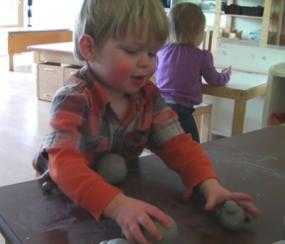Clay Balls Together

This short clip focuses on a toddler, who is offered a variety of clay balls. It starts with the child attaching a small ball on top of a larger ball, in imitation of the creation the teacher has provided as a provocation. When he tries to add a second small ball, both balls fall off. He places the small ball on top of the large one, but he does not press to make them stick. What does this strategy say about his theory, his understanding of the physical nature of clay (see also “Poke, Scrape, Slap”)? He continues to experiment and finally achieves success. He places a small ball on a large ball stating, “One.” He then creates a second balanced ball, again stating, “One.” To what does “one” refer? Is he saying, “I have made the one I want” or perhaps “Now I have made these two parts into one whole” or perhaps ""I have put one small ball on top of the large ball, just as the teacher did"? Notice his aborted move as he first attempts to place a second small ball on an existing set and instead places this ball on a larger one that is as yet unoccupied. Could we say he is using a rule? How can we use materials such as clay to support scientific and mathematical concepts? What can we observe about the child’s learning process based on his aborted move? At the end of the clip, the boy leaves, and a girl, who had been working at a nearby table, begins to play with the balls of clay. Notice how she bangs the two identical balls at her midline. Research suggests that this bilateral banging is the beginning of the child’s concept of equivalence (A = A). What do you anticipate she will do after the clip ends?
